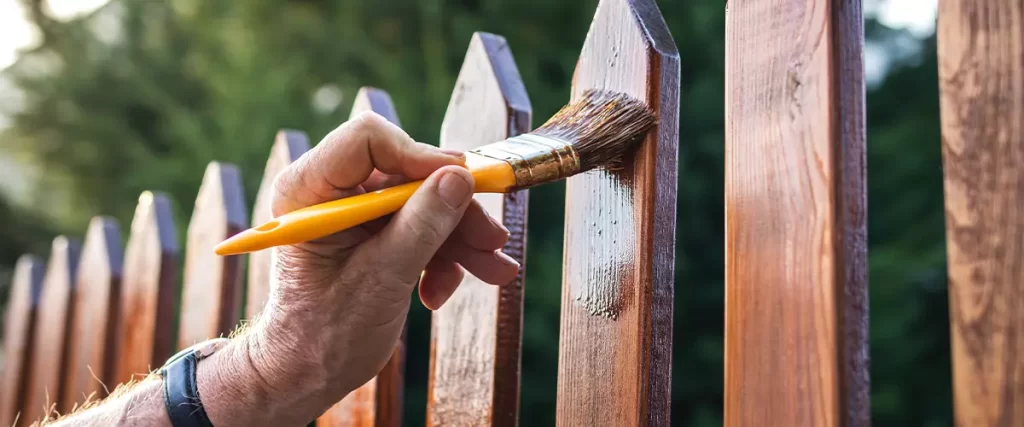Keeping your wooden fence resilient against the ever-changing WA weather can be a challenging task.
Water, wind, and sun exposure contribute to accelerated rot and decay in wooden fences, and leaving this structure unprotected will result in costly repairs down the road.
This blog will guide you step-by-step on how to effectively seal your wood fence for fortified protection from these elements.
Continue reading to discover what wood fence waterproofing can do to your fence.

Key Takeaways
- The recommended temperature range for interior painting is between 50 to 85 degrees Fahrenheit.
- Extreme temperatures can affect the drying process and adhesion of the paint.
- Using good quality sealer helps keep out water that can rot the wood.
- Stains make your fence look great and help it last longer against bad weather.
- Regular cleaning helps stop dirt, green stuff, and damage to your fence.
Weatherproofing Strategies for Your Fence
Weatherproofing your fence involves selecting durable materials, installing posts correctly, and ensuring you have open panels. Applying finishing stains is another crucial step to shield your fence from WA weather, thereby extending its lifespan and maintaining its aesthetics.
Material Selection
You need to choose the right stuff for your fence. If you want durability and strength, go for durable woods like cedar, teak, and redwood that stand up well to rain. They fight off rot and bugs, too. If you can’t find these woods, pressure-treated pine is an affordable option that you can seal and stain for maximum longevity.
Post Installation
Treating a fence post against rot is crucial to ensure the longevity and structural integrity of your fence.
If using pressure-treated wood, ensure it’s rated for ground contact to provide the highest level of protection. Before installation, remove any debris and make sure the post is not in direct contact with the soil, as moisture is a primary contributor to rot. Consider using a post cap or gravel base to create a barrier between the post and the ground.
Apply a water-resistant sealant or primer to all exposed wood surfaces, focusing on the end grain where moisture can easily seep in.
Open Panels
Adequate air circulation helps prevent the buildup of moisture, which can lead to various problems such as wood rot, mold growth, and deterioration. Proper air movement minimizes the chances of moisture getting trapped between the fence boards or within crevices, thereby reducing the risk of long-term damage.
By allowing air to flow freely through the fence, you create a healthier environment that discourages the growth of fungi, preserves the structural integrity of the wood, and ultimately contributes to the fence’s aesthetic appeal and functionality for years to come.
Finishing Stains
A wood stain gives your fence a great look and makes the wood last longer against bad weather. All you have to do is pick a stain color that you like and then follow the manufacturer’s instructions to apply it correctly.
Wood stains for outdoor use need to be durable and able to withstand the elements. Here are three types of wood stains suitable for outdoor applications:
Oil-Based Stains: Oil-based stains penetrate the wood deeply, providing excellent protection against moisture and UV rays. They enhance the natural beauty of the wood and create a rich, even color. However, they tend to require more maintenance and may need to be reapplied every couple of years as they wear away. Oil-based stains provide a classic look and are available in a wide range of colors.
Water-Based Acrylic Stains: Water-based acrylic stains are known for their quick drying time, low odor, and ease of cleanup. They offer good protection against UV rays and moisture, and they come in a variety of colors. Acrylic stains tend to retain their color for a longer period compared to oil-based stains. They’re also more environmentally friendly as they emit fewer volatile organic compounds (VOCs).
Semi-Transparent and Solid Color Stains: These type of fence stain is available in both oil-based and water-based formulas. Semi-transparent stains allow some of the wood grain to show through, providing a natural appearance while adding color and protection. Solid color stains, on the other hand, provide a more opaque finish, effectively covering the wood’s natural grain. Both types of stains offer good UV protection and moisture resistance. Solid color stains are particularly useful for older or weathered wood that might have imperfections.

How to Seal a Wood Fence
Discovering the ideal time to seal your fence, preparing the wood surface correctly, balancing the PH level of your timber, and finally mastering how to effectively apply sealant are all crucial steps in protecting your wooden fence from WA’s unpredictable weather.
Learn these essential techniques for sealing a wood fence by reading more below!
When to Seal A Fence
Sealing a fence is best done in dry weather. After you install your wood fence, give it time to dry for about 1-2 weeks if it’s new. This waiting period lets the wood lose its moisture.
Don’t seal when rain or heavy dew is expected in the next 24 hours. Humid climates like we’re seeing in Washington State may need more drying time for fences.
The heat can also cause problems while sealing your fence. If it’s too hot outside, the sealer might not stick well to your wood fence. Try sealing on cooler days, but not too cool, as low temperatures may stop the sealer from working right.
Prepare the Wood
Start with a clean fence. Take off any dust, dirt, or green stuff you see. Use a pressure washer, but be careful not to damage the wood fibers. Let it dry for two full days before sealing.
Balance the PH of the Wood
It’s important to make the wood’s PH level right. This works like magic in sealing a fence in WA weather or any other place. Wood with too much acid can harm the seal you put on it.
Use a PH balancer on the wood before sealing it. This will keep your fence safe from rot and decay for longer. Now, you’re ready to seal the fence.
Regular Wood Fences Maintenance
Taking care of your wood fence is easy with these tips:
– Clean the fence at least once a year. Use soapy water and a soft brush.
– Check for any loose nails or screws. Fix them right away.
– Look for signs of rot or decay. Clear leaves and other debris from the base regularly to stop rot.
– Treat any spots of rust on metal parts with rust converter.
– Reapply sealant every few years to keep your fence waterproof and shiny.
– Filling in splits or cracks with wood filler will help your fence last longer.
With these steps, you can have a good-looking, strong wood fence for years!

Conclusion
You now know how to seal a fence for WA weather. Use the right materials and steps. Keep your fence looking good for many years! It is easy if you follow these steps!
